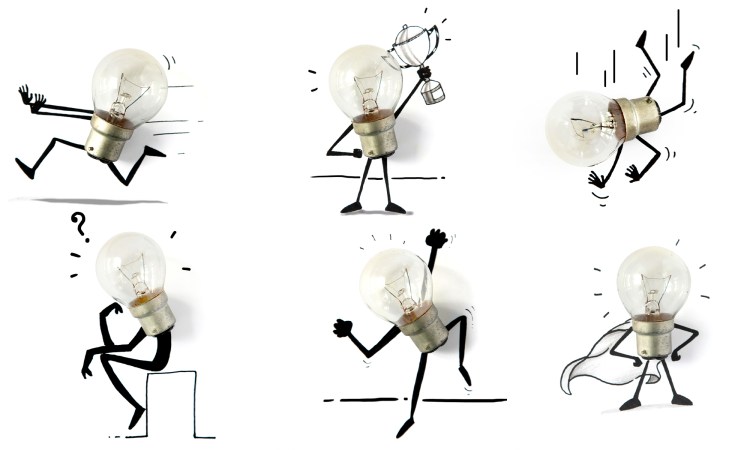
All the good ideas must be taken by now.
Back when Dr. Seuss was writing, there were only tens of thousands of books for kids. Now, there are millions to choose from. The same is true for movie script ideas, summer camp special days, niches for surgeons, original landscaping ideas . . .
It’s tempting to imagine that there’s no possible way to make a contribution. The muse has passed you by and there’s nothing left to create.
Instead of saying, “I’m stuck, I can’t come up with anything good,” it’s far more effective to say, “I’ve finished this, and now I need to make it better.” Or possibly “I finished this, and it can’t be made better, but now I’m ready to do the new thing, because look at all I’ve learned.”
This is the story of every human innovation.
This is the story of every good idea, every new project, every pop song, every novel.
There was a bad idea. And then there was a better one.
If you want to complain that you don’t have any good ideas, please show me all your bad ideas first.
Befriending your bad ideas is a useful way forward. They’re not your enemy. They are essential steps on the path to better.
The smallest viable breakthrough
Could you rewrite one paragraph of Fahrenheit 451 and make it better than Ray Bradbury’s version?
Could you write one new page for the screenplay of The Matrix?
Can you play just one note on the clarinet that’s worth listening to?
Instead of focusing on a masterpiece, ask yourself, What’s the smallest unit of available genius?
What’s the bar of music, the typed phrase, the personal human interaction that makes a difference?
Don’t worry about changing the world.
First, focus on making something worth sharing. How small can you make it and still do something you’re proud of?
The wild side
In 1972, Herbie Flowers was a session musician. He showed up with his double bass guitar and did what was asked of him.
David Bowie had worked with Flowers on Space Oddity, so when Lou Reed asked Bowie for a recommendation, he made the connection to Flowers.
Reed gave Flowers a bar of music to play. In the moment, Herbie asked Lou if it was okay if he experimented a bit. He decided to do an overdub — using an electric bass to go 10 notes above the double bass track he’d already recorded.
The result: the haunting backbone of “Take a Walk on the Wild Side.”
In 20 minutes, Herbie Flowers delivered a tiny bit of genius and ensured Lou Reed’s career. Of course, it took more than 20 minutes. It took a decade of building his craft and learning to see and to listen.
“How do I make this better?” is different than “How do I make this?”
That’s the way our culture works. It’s easy to get a committee together to criticize the new logo that your agency put together. It’s almost impossible to find someone willing to make the logo itself.
We’re a community of critics and tweakers and tinkerers. The reason is simple: It’s safer. People rarely criticize the critic. And beyond that, it’s not that hard to use sandpaper. It’s a lot more difficult to use a bandsaw, or even to use a pencil to draw the plans in the first place.
There’s a huge clue here about what to do next: Get a pencil.
That’s what’s scarce. People who will draw up plans. People who will go first.
After that, you can easily get help from one of the people who are good at using sandpaper, now that you’ve done just about all of the scary bits.
What does “good” mean?
No one wants to make lousy work. We seek out “good” or even “great”.
But how, exactly, do we judge our work? It might be a trap to ask someone else (or yourself) if your work is any good. It’s a trap because you might be tempted to judge “good” by commercial success. Or feedback from gatekeepers.
Was Harry Potter not good when it was rejected by 12 publishers? Did it suddenly become good after it became a worldwide phenomenon? How can the same book be good and not good at the same time?
Good needs to be defined before you begin. What’s it for and who’s it for? If it achieves its mission, then it’s good. If it doesn’t, then either you were unlucky, incorrect, or perhaps, what you created didn’t match what you set out to do.
And yes, there’s a huge gap between “good” and “as good as it could be.” It’s likely we’ll never bridge that gap.
Protecting your perfect idea
How much does it help you to know that you have something special in reserve, something unseen, something yet to be discovered?
You won’t run out. This isn’t your one and only shot. There’s no perfect idea, just the next thing you haven’t shipped yet.
No one is keeping you from posting your video.
No one is keeping you from blogging every day.
No one is keeping you from hanging your artwork.
The only way to get through the steps is to do the steps.
Excerpted with permission from the new book The Practice: Shipping Creative Work by Seth Godin. Published by Portfolio, an imprint of Penguin Publishing Group, a division of Penguin Random House, LLC. © Copyright 2020 Seth Godin. All rights reserved.
Watch this quick TED Talk from Seth Godin:










